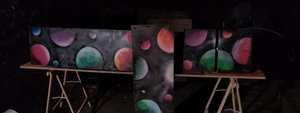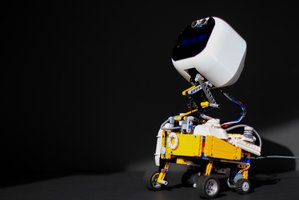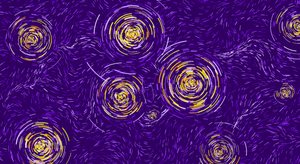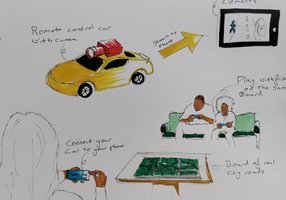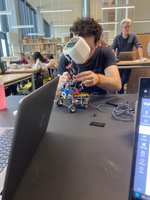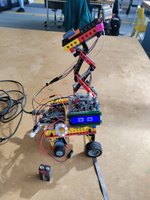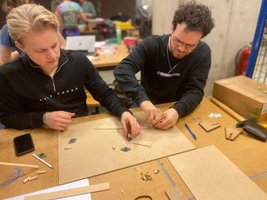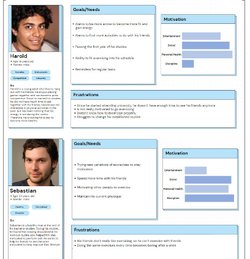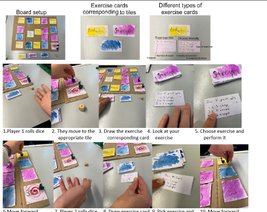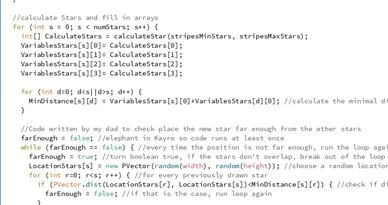Prior to studying
Industrial design.
As a kid, throughout my teenage years, I always enjoyed being creative. I would draw and paint a lot and occasionally I would pick up woodworking projects, I very much enjoyed making things. Which now finds its outlet in my prototyping passion.
In high school I enjoyed the subject of art, I found a real passion for creating high-quality products and often lost myself in the production process. Towards the end of my years, my focus switched more towards the story that my art tells instead of the quality of my piece.
I didn't always want to be a designer, for a while I thought I wanted to be an architect. This was because I had a passion for art and I wanted to combine that with my competence in mathematics. However, in my years of studying architecture, I did a few extracurricular projects that led to my decision to study Industrial design. These projects were all related to light art. I did two projects for Glow and designed one project for the Amsterdam Light Festival. In these projects, I got my first experience with a design process and got enthusiastic about the freedom for creativity that designers have, compared to architects.
Business & Entrepreneurship
Paintings I made and sold in the use course
I haven't yet stumbled across the Business & Entrepreneurship expertise area in my curriculum. The only experience I have with it was in my previous study, I followed the use course "Entrepreneurship in Action". In this course, I learned about the principle of creating a product with value from a relatively low budget.
In my vision I stated that I wanted to go to developing countries to aid them, one challenge that arises in this ambition is that I can't make products to sell there, I'd need a different business plan. In the next year, I want to learn more about the different ways to set up a company and how to deal with the finances around it.
Aesthetic interface design for creative programming
Aesthetic design for creative electronics
Design for creative programming
Drawings for project 1
This year I learned how to use my eye for aesthetics to create functional products that are also aesthetically pleasing. I learned how to combine function and aesthetics. In Project 1 I set out to create a board game that had a nostalgic aesthetic. This I did by comparing the aesthetics of an old game mat and applying the principles to our design. Also for creative programming, I looked at using complimentary colors in my design, and finally, for the creative electronics assignment, I looked at how to create an aesthetic casing (built with legos) to encase the functionality of our robot in a way that adds to its story.
I have always been very interested in the creativity and aesthetics of a project. As I have already mentioned, I enjoyed learning new techniques to be creative and I make a lot of aesthetic paintings.
I also learned how to use sketching techniques to convey our concept. I used this for our final presentation of Project 1.
I intend to use this techunique in future projects to present different iterations of a design.
Creativity & Aesthetics
Technology & Realization
Electronics for project 1
Me, working on the
mechanics for creative
electronics
Electronical components for creative electronics
Working together with Xann on the design for movement assignment
In the past year I developed a lot in the technology and realization area. I learned a bunch of skills about using electronics and programming to create working prototypes.
My prior experience with technology was with my projects for the Glow festival. Here I learned how to work with LED's. In Project 1 I also used some electronics by wiring up a simple circuit with a traffic light and a motor to pull a magnet. In my third quartile, this expertise area grew the most, I learned how to program in the Arduino IDE and Processing, and I learned how to work with sensors and actuators, and how to get them to work together. I also learned how to create programs that a user can interact with with an Arduino-built prototype.
These are all very useful skills when it comes to making prototypes. One thing I learned was the importance of starting to build and program these prototypes early in the design process, often I would stumble across something that didn't work as intended and needed readjusting, this process plays a key role in the different iterations of a design.
I find these tools very rewarding to use and am keen to incorporate them in my future projects.
Personas for human-centered design
Prototype made to do user testing
In the user and society expertise area, I learned about the importance of designing from the users' perspective. I learned how to find the requirements that the user has for a product and how to keep those requirements in mind while designing.
In the course human-centered design I learned how to do structured or semi-structured interviews with users to understand their needs. I learned how to use that information to develop personas and also how to make decisions in the design process based on these personas. I also learned how to validate the decisions by doing user tests.
Though I haven't officially incorporated these techniques in other projects yet, I did a semi-user test with the product I made for creative programming to see whether the program was intuitive to use.
I intend to use these techniques earlier in my future projects, before starting to design, having a clear understanding of the requirements for a design is vital for a good design.
User & Society
Affinity diagram for human centered design.
Code used to evaluate the distance and variables of stars drawn in my creative programming assignment
During the past year, I followed two courses that taught me skills to sort and organize data.
In Human-centred design, I learned how to sort data from interviews into an affinity diagram, which I could then use to easily visualize the results to find patterns and create personas. And in creative programming, I learned how to create programs that can automatically sort and work with numerical data. I used this to create an artistic visualization from real-time values gotten from potmeters, but this could be used in combination with any sensors.
What I find most promising about using processing to sort data is that you can make your prototype react immediately to the data it is collecting.
I feel like this is a very valuable tool to use in the design process and I want to become more acquainted with its different use cases.
Math, Data & Computing
Design & Research process
My understanding of how a design process should look has developed a lot over the past year.
At the beginning of the year, I only had experience with a linear design process. Where I had a problem, then would think of a solution, and finish by fine-tuning my solution. This was also very monotone, everything would come from my vision.
When we did Project 1 we had our first experience with a reflective transformative design process. I didn't fully understand it but I tried to look at different drivers in the design process. At the end of the project, I understood how the different drivers work, in combination with what I learned in Human-centered design, I began to see the importance of combining user input while designing solutions.
Also through the courses I took in Q3, I began to see the value of using a lot of prototypes and building things to come up with solutions. Often in testing and building prototypes, you will stumble upon problems that you won't find by merely analyzing the problem.
Therefore my idea for the design process is to start by connecting with the users to find requirements, and after you have your requirements you should start doing hands-on brainstorming to think of solutions that fit these requirements. These solutions can than be brought back to the users to test if the solutions work so the process can continue.
I intend to test this process out in my next project.
Prototyping
At the beginning of the year, I saw how useful prototyping was for the design process. This is why set myself the goal to get better at prototyping by learning a few skills. These skills were learning electronics, 3d modeling, and programming. I found a few courses and online modules that I wanted to attend in Q2 to learn these skills.
Sadly I wasn't able to learn any of these skills in Q2, I did not have the time to do so.
Luckily in Q3, we had courses in our curriculum that taught us exactly these skills.
I followed these courses and enjoyed learning these skills. I believe that they will be very valuable to me as a designer.
Teamwork
My goal this year was to become more comfortable with working within a team. Before this year I was very unsure about myself and shy around people. This led to me not coming up with ideas but following along with other people's ideas.
This year I set out to have a more involved role in the team, to present my ideas and help in making decisions.
At the beginning of my first project, this went well, I could give my input and steer the project toward something that I was also enthusiastic about. I however had a different issue in my group where I seemed to be the only one willing to put in effort for the project. This led to me doing almost all of the work.
In my second project, I had to learn to trust my team and value their input. This has gone quite well and I am quite content with how the teamwork was.
One thing I noticed was that we couldn't make decisions together but everyone had their tasks and things they designed which we fitted together as one final product. In my coming projects, I would like to develop my skills of brainstorming together and building on one another's ideas.
Vision
The most important goal I had was finding my role as a designer in this world.
I did this by looking at what designers around me do. I concluded that I wanted the things I designed to be of value to the people around me.
After praying about it I realized that I had the desire to help people in need, that God could use me in such a way. I began thinking about doing something in developing countries.
At the same time, I began forming a passion for working with children and helping them develop.
These two passions seemed like a logical fit, however it is not clear yet to me how they will fit together.
For next year I want to look into this more, I want to talk to people with similar goals and find out what they are focussing on, so I can get inspiration for my vision.
